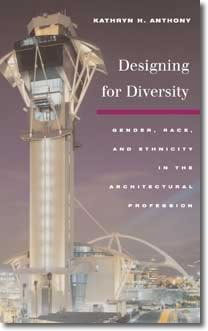
by Kathryn H. Anthony (University of Illinois Press, 2001)
reviewed by John Cary Jr., Assoc. AIA
 Designing
for Diversity is a must-read for anyone who cares about the architecture
profession, regardless of their gender, race, or ethnicity. For all, it
is a startling reminder of issues that haunt our profession long after
they have been acknowledged in many other professions and walks of life.
More specifically, this landmark book offers deep insight into our profession's
unusually high attrition rate, particularly among women and minorities.
Designing
for Diversity is a must-read for anyone who cares about the architecture
profession, regardless of their gender, race, or ethnicity. For all, it
is a startling reminder of issues that haunt our profession long after
they have been acknowledged in many other professions and walks of life.
More specifically, this landmark book offers deep insight into our profession's
unusually high attrition rate, particularly among women and minorities.
Optimism
In a time of frequent finger pointing and of no ongoing, comprehensive
assessment of architecture education and practice, Anthony's book offers
fresh perspectives on our glacial evolution, existing dilemmas, and options
for moving forward. A decade after its release, Anthony effectively builds
on her original research and writing on design studio culture, Design
Juries on Trial. Like its predecessor, Designing
for Diversity is written with emotion and determination, empowering
its readers. Anthony also draws extensively from a unique course focusing
on gender and race in architecture that she teaches at the University
of Illinois, from which she enlisted the research assistance of dozens
of students.
Armed with every reason to do otherwise, Anthony expresses optimism about the future of the profession. To accentuate the positive, she introduces a number of individuals from traditionally underrepresented groups who have overcome unimaginable obstacles and led successful careers despite the odds. Each of the book's eight chapters makes a case for immediate reform of our profession. Can our "white gentlemen's" profession overcome its past and put down its guard to welcome and support this change? Anthony argues—quite convincingly—that we can.
Challenges ahead
Using a careful balance of statistically loaded and simple language, Anthony
issues a series of challenges for students, educators, interns, architects,
and the organizations representing these important groups. If anything,
the simplicity of Anthony's language may prove to be the pitfall of the
book: The perfectly crafted and edited text often softens the dire situation
we face and its urgency.
Another possible limitation is her choice of media: a print publication. For, as the author herself notes in her final chapter, the messages contained in this text requires accessible, active, and determined advocates in schools and firms, as well as in the collateral organizations. Beyond electronic distribution to every member of our profession, Anthony's message warrants real-time delivery at the dozens of architecture-related conferences and symposia each year. And although Anthony presumably will continue to make every effort to do so, the majority of our colleagues may never hear or understand her message.
So, take a first and necessary step yourself and pass on Anthony's message by word and example. Our profession will be a more respectable and welcoming place because of her efforts—and yours.
Copyright 2002 The American Institute of Architects. All rights reserved.
![]()
|
John Cary, a graduate student at UC Berkeley, is coeditor of ArchVoices.org and former editor of the American Institute of Architecture Students' Crit magazine. |
|